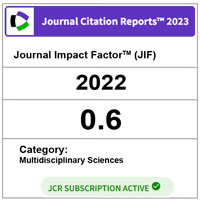Analysis of bioactive compounds for Jasmine flower via Gas chromatography-mass spectrometry (GC-MS)
DOI:
https://doi.org/10.11113/mjfas.v14n2.884Keywords:
Essential oil, jasmine flower, microwave-assisted hydrodistillation (MAHD), gas chromatography-mass spectroscopy (GC-MS)Abstract
The current work analyses the chemical constituents of Jasmine flower using Chromatography-Mass Spectrometry (GC-MS). The dried Jasmine flower powder was extracted by methanol via the Microwave-assisted Hydrodistillation (MAHD) process. The GC-MS analysis revealed different peaks that showed the presence of ten compounds. In the current study, we have focused on the main compounds that can be used for biological activity, i.e. 2-Phenylthiolane (57.31%), Cyclohexene, 3-ethenyl- (25.91%), Acetaldehyde (12.70%), N-Methylallylamine (9.99%), Propanamide (6.79%) and Phthalic acid, bis (7-methyloctyl) ester (5.21%). The bio-compounds with methanol extract of Jasmine flower were analyzed by using GC-MS. Functional group analysis was carried out on the volatile oil obtained through MAHD by using Fourier Transform Infrared Spectroscopy (FTIR). The surface morphologies of untreated dried powdered Jasmine flower (i.e. raw powdered jasmine flower without soaking into methanol solution prior to extraction) and pre-treated powdered Jasmine flower (soaked into methanol solution for 1 hr) were investigated through SEM analysis.
References
Burt, S. Essential oils: their antibacterial properties and potential applications in foods-a review. 2004. International Journal of Food Microbiology, 94(3), 223-253.
Younis, A., Riaz, A., Khan, M. A., Khan, A. A. 2006. Extraction and identification of chemical constituents of the essential oil of Rosa species. in XXVII International Horticultural Congress-IHC2006: International Symposium on Ornamentals, Now! 766, 485-492.
Formaceck, V., Kubeczka, K. H. 1982. Essential oil by capillary gas chromatography and carbon 13 NMR spectroscopy. John Wiley and Sons.
Oussalah, M., Caillet, S., Saucier, L. 2006. Antimicrobial effects of selected plant essential oils on the growth of a Pseudomonas putida strain isolated from meat. Meat Science, 73(2), 236-244.
Oussalah, M., Caillet, S., Saucier, L., Lacroix, M. 2007. Inhibitory effects of selected plant essential oils on the growth of four pathogenic bacteria: E. coli O157: H7, Salmonella typhimurium, Staphylococcus aureus and Listeria monocytogenes. Food Control, 18(5), 414-420.
Bramhachari, P., Ravichand, J., Reddy, Y., Kotresha, D., Chaitanya, K.V., Bobbarala, V. 2011. Evaluation of hydroxyl radical scavenging activity and HPTLC fingerprint profiling of Aegle marmelois (L.) Correa extracts. Journal of Pharmacy Research, 4(1), 252-255.
Gordon, D. M. 2001. Geographical structure and host specificity in bacteria and the implications for tracing the source of coliform contamination. Microbiology, 147(5), 1079-1085.
Sheeja, K., Kuttan, G. 2007. Activation of cytotoxic T lymphocyte responses and attenuation of tumor growth in vivo by Andrographis paniculata extract and andrographolide. Immunopharmacology and Immunotoxicology, 29(1), 81-93.
Mukherjee, P. K., Kumar, V., Houghton, P. J. 2007. Screening of Indian medicinal plants for acetylcholinesterase inhibitory activity. Phytotherapy Research, 21(12), 1142-1145.
Muthulakshmi, A., Margret, R. J., Mohan, V. 2012. GC-MS analysis of bioactive components of feronia elephantum correa (Rutaceae). Applied Pharmaceutical Science, 2, 69-74.
Lucchesi, M. E., Chemat, F., Smadja, J. 2004. An original solvent free microwave extraction of essential oils from spices. Flavour and Fragrance Journal, 19(2), 134-138.
Farhat, A., Ginies, C., Romdhane, M., Chemat, F. 2009. Eco-friendly and cleaner process for isolation of essential oil using microwave energy: experimental and theoretical study. Journal of Chromatography A, 1216(26), 5077-5085.
Golmakani, M.-T., Rezaei, K. 2008. Comparison of microwave-assisted hydrodistillation withthe traditional hydrodistillation method in the extractionof essential oils from Thymus vulgaris L. Food Chemistry, 109(4), 925-930.
Brachet, A., Christen, P., Veuthey, J. L. 2002. Focused microwave‐assisted extraction of cocaine and benzoylecgonine from coca leaves. Phytochemical Analysis, 13(3), 162-169.
Mandal, V., Mohan, Y., Hemalatha, S. 2007. Microwave assisted extraction–an innovative and promising extraction tool for medicinal plant research. Pharmacognosy Reviews, 1(1), 7-18.
Wang, H., Liu, Y., Wei, S., Yan, Z. 2012. Comparative seasonal variation and chemical composition of essential oils from the leaves and stems of Schefflera heptaphylla using microwave-assisted and conventional hydrodistillation. Industrial Crops and Products, 36(1): p. 229-237.
Rassem, H. H., Nour, A. H., Yunus, R. M. 2017. GC-MS analysis of bioactive constituents of Hibiscus flower. Australian Journal of Basic and Applied Sciences, 11(3), 91-97.







